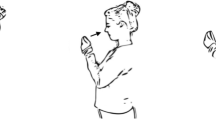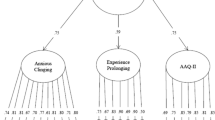Abstract
Several literatures converge on the idea that approach and avoidance/withdrawal behaviors are managed by two partially distinct self-regulatory system. The functions of these systems also appear to be embodied in discrepancy-reducing and -enlarging feedback loops, respectively. This article describes how the feedback construct has been used to address these two classes of action and the affective experiences that relate to them. Further discussion centers on the development of measures of individual differences in approach and avoidance tendencies, and how these measures can be (and have been) used as research tools, to investigate whether other phenomena have their roots in approach or avoidance.

Similar content being viewed by others
References
Cacioppo, J. T., Gardner, W. L., & Berntson, G. G. (1999). The affect system has parallel and integrative processing components: Form follows function. Journal of Personality and Social Psychology, 76, 839–855.
Campos, J. J., Frankel, C. B., & Camras, L. (2004). On the nature of emotion regulation. Child Development, 75, 377–394.
Carver, C. S. (2003). Pleasure as a sign you can attend to something else: Placing positive feelings within a general model of affect. Cognition and Emotion, 17, 241–261.
Carver, C. S. (2004). Negative affects deriving from the behavioral approach system. Emotion, 4, 3–22.
Carver, C. S., Lawrence, J. W., & Scheier, M. F. (1999). Self-discrepancies and affect: Incorporating the role of feared selves. Personality and Social Psychology Bulletin, 25, 783–792.
Carver, C. S., & Scheier, M. F. (1990). Origins and functions of positive and negative affect: A control-process view. Psychological Review, 97, 19–35.
Carver, C. S., & Scheier, M. F. (1998). On the self-regulation of behavior. New York: Cambridge University Press.
Carver, C. S., & Scheier, M. F. (1999). Themes and issues in the self-regulation of behavior. In R. S. Wyer, Jr. (Ed), Advances in social cognition (Vol. 12). Mahwah, NJ: Erlbaum.
Carver, C. S., & Scheier, M. F. (2000). Autonomy and self-regulation. Psychological Inquiry, 11, 284–291.
Carver, C. S., & Scheier, M. F. (in press). Self-regulatory systems: Action and affect. In J. Y. Shah & W. Gardner (Eds.), Handbook of motivation science. New York: Guilford.
Carver, C. S., Sutton, S. K., & Scheier, M. F. (2000). Action, emotion, and personality: Emerging conceptual integration. Personality and Social Psychology Bulletin, 26, 741–751.
Carver, C. S., & White, T. L. (1994). Behavioral inhibition, behavioral activation, and affective responses to impending reward and punishment: The BIS/BAS scales. Journal of Personality and Social Psychology, 67, 319–333.
Clark, R. N. (1996). Control system dynamics. New York: Cambridge University Press.
Cloninger, C. R. (1987). A systematic method of clinical description and classification of personality variants: A proposal. Archives of General Psychiatry, 44, 573–588.
Davidson, R. J. (1984). Affect, cognition, and hemispheric specialization. In C. E. Izard, J. Kagan, & R. Zajonc (Eds.), Emotion, cognition, and behavior (pp. 320–365). New York: Cambridge University Press.
Davidson, R. J. (1988). EEG measures of cerebral asymmetry: Conceptual and methodological issues. International Journal of Neuroscience, 39, 71–89.
Davidson, R. J. (1995). Cerebral asymmetry, emotion, and affective style. In R. J. Davidson, & K. Hugdahl (Eds.), Brain asymmetry (pp. 361–387). Cambridge, MA: MIT Press.
Davidson, R. J. (1998). Affective style and affective disorders: Perspectives from affective neuroscience. Cognition and Emotion, 12, 307–330.
Depue, R. A., & Collins, P. F. (1999). Neurobiology of the structure of personality: Dopamine, facilitation of incentive motivation, and extraversion. Behavioral and Brain Sciences, 22, 491–517.
Depue, R. A., & Iacono, W. G. (1989). Neurobehavioral aspects of affective disorders. Annual Review of Psychology, 40, 457–492.
Depue, R. A., Krauss, S. P., & Spoont, M. R. (1987). A two-dimensional threshold model of seasonal bipolar affective disorder. In D. Magnusson & A. Öhman (Eds.), Psychopathology: An interactional perspective (pp. 95–123). Orlando, FL: Academic Press.
Elliot, A. J., & Thrash, T. M. (2002). Approach–avoidance motivation in personality: Approach and avoidance temperaments and goals. Journal of Personality and Social Psychology, 82, 804–818.
Fowles, D. C. (1980). The three arousal model: Implications of Gray’s two-factor learning theory for heart rate, electrodermal activity, and psychopathy. Psychophysiology, 17, 87–104.
Frijda, N. H. (1986). The emotions. Cambridge, England: Cambridge University Press.
Frijda, N. H. (1988). The laws of emotion. American Psychologist, 43, 349–358.
Frijda, N. H. (1994). Emotions are functional, most of the time. In P. Ekman & R. J. Davidson (Eds.), The nature of emotion: Fundamental questions (pp. 112–126). New York: Oxford.
Gray, J. A. (1981). A critique of Eysenck\(^{\prime}\)’s theory of personality. In H. J. Eysenck (Ed.), A model for personality (pp. 246–276). Berlin: Springer-Verlag.
Gray, J. A. (1987). Perspectives on anxiety and impulsivity: A commentary. Journal of Research in Personality, 21, 493–509.
Gray, J. A. (1990). Brain systems that mediate both emotion and cognition. Cognition and Emotion, 4, 269–288.
Gray, J. A. (1994a). Personality dimensions and emotion systems. In P. Ekman & R. J. Davidson (Eds.), The nature of emotion: Fundamental questions (pp. 329–331). New York: Oxford University Press.
Gray, J. A. (1994b). Three fundamental emotion systems. In P. Ekman & R. J. Davidson (Eds.), The nature of emotion: Fundamental questions (pp. 243–247). New York: Oxford University Press.
Higgins, E. T. (1996). Ideals, oughts, and regulatory focus: Affect and motivation from distinct pains and pleasures. In P. M. Gollwitzer & J. A. Bargh (Eds.), The psychology of action: Linking cognition and motivation to behavior (pp. 91–114). New York: Guilford.
Higgins, E. T. (1997). Beyond pleasure and pain. American Psychologist, 52, 1280–1300.
Izard, C. E. (1977). Human emotions. New York: Plenum.
Johnson, S. L., & Carver, C. S. (in press). Extreme goal setting and vulnerability to mania among undiagnosed young adults. Cognitive Therapy and Research.
Johnson, S. L., Turner, R. J., & Iwata, N. (2003). BIS/BAS levels and psychiatric disorder: An epidemiological study. Journal of Psychopathology and Behavioral Assessment, 25, 25–36.
Konorski, J. (1948). Conditioned reflexes and neuron organization. Cambridge, England: Cambridge University Press.
Lang, P. J., Bradley, M. M., & Cuthbert, B. N. (1998). Emotion, motivation, and anxiety: Brain mechanisms and psychophysiololgy. Biological Psychiatry, 44, 1248–1263.
Levenson, R. W. (1994). Human emotion: A functional view. In P. Ekman & R. Davidson (Eds.), The nature of emotions: Fundamental questions (pp. 123–126). New York: Oxford University Press.
Markus, H., & Nurius, P. (1986). Possible selves. American Psychologist, 41, 954–969.
Meyer, B., Johnson, S. L., & Carver, C. S. (1999). Exploring behavioral activation and inhibition sensitivities among college students at risk for bipolar spectrum symptomatology. Journal of Psychopathology and Behavioral Assessment, 21, 275–292.
Meyer, B., Johnson, S. L., & Winters, R. (2001). Responsiveness to threat and incentive in bipolar disorder: Relations of the BIS/BAS scales with symptoms. Journal of Psychopathology and Behavioral Assessment, 23, 133–143.
Miller, N. E. (1944). Experimental studies of conflict. In J. McV. Hunt (Ed.), Personality and the behavior disorders (Vol. 1, pp. 431–465). New York: Ronald Press.
Miller, N. E., & Dollard, J. (1941). Social learning and imitation. New Haven: Yale University Press.
Ogilvie, D. M. (1987). The undesired self: A neglected variable in personality research. Journal of Personality and Social Psychology, 52, 379–385.
Ortony, A., Clore, G. L., & Collins, A. (1988). The cognitive structure of emotions. New York: Cambridge University Press.
Powers, W. T. (1973). Behavior: The control of perception. Chicago: Aldine.
Roseman, I. J. (1984). Cognitive determinants of emotions: A structural theory. In P. Shaver (Ed.), Review of personality and social psychology (Vol. 5, pp. 11–36). Beverly Hills, CA: Sage.
Russell, J. A., & Carroll, J. M. (1999). On the bipolarity of positive and negative affect. Psychological Bulletin, 125, 3–30.
Ryan, R. M., & Deci, E. L. (1999). Approaching and avoiding self-determination: Comparing cybernetic and organismic paradigms of motivation. In R. S. Wyer, Jr. (Ed.), Advances in social cognition (Vol. 12, pp. 193–215). Mahwah, NJ: Erlbaum.
Schneirla, T. C. (1959). An evolutionary and developmental theory of biphasic processes underlying approach and withdrawal. In M. R. Jones (Ed.), Nebraska symposium on motivation (Vol.7, pp. 1–42). Lincoln: University of Nebraska Press.
Underwood, B. J. (1975). Individual differences as a crucible in theory construction. American Psychologist, 30, 128–134.
Watson, D., Wiese, D., Vaidya, J., & Tellegen, A. (1999). The two general activation systems of affect: Structural findings, evolutionary considerations, and psychobiological evidence. Journal of Personality and Social Psychology, 76, 820–838.
Zelenski, J. M., & Larsen, R. J. (1999). Susceptibility to affect: A comparison of three personality taxonomies. Journal of Personality, 67, 761–791.
Zuckerman, M. (2005). Psychobiology of personality (2nd ed.). New York: Cambridge University Press.
Author information
Authors and Affiliations
Corresponding author
Rights and permissions
About this article
Cite this article
Carver, C.S. Approach, Avoidance, and the Self-Regulation of Affect and Action. Motiv Emot 30, 105–110 (2006). https://doi.org/10.1007/s11031-006-9044-7
Published:
Issue Date:
DOI: https://doi.org/10.1007/s11031-006-9044-7




